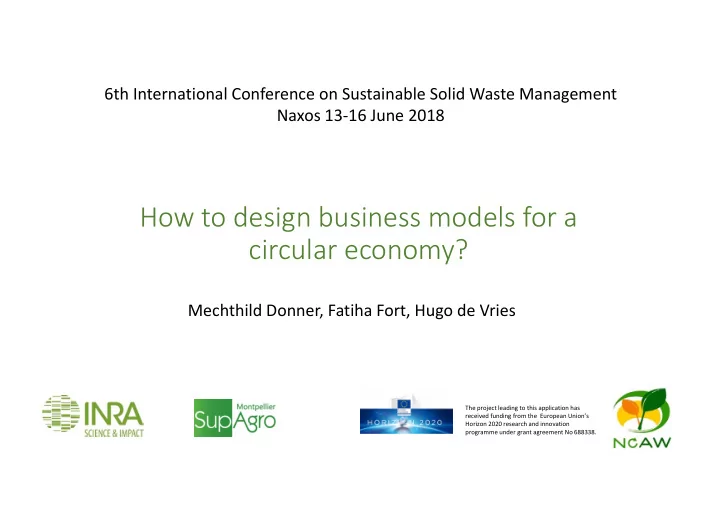

6th International Conference on Sustainable Solid Waste Management Naxos 13 ‐ 16 June 2018 How to design business models for a circular economy? Mechthild Donner, Fatiha Fort, Hugo de Vries The project leading to this application has received funding from the European Union’s Horizon 2020 research and innovation programme under grant agreement No 688338.
Con Context and and pr problem oblem state statement Source: article from ‚Le Monde‘ 09.04.2015
Wh What at is is Ci Circular ular Ec Economy? • Circular economy = a new, alternative, more sustainable economic model < ‐ > Linear economy = ‘take ‐ make ‐ dispose’ • Closed loop idea: reduce waste to a minimum, keep products, components and materials at their highest utility and value at all times by sharing, leasing, reusing, repairing and recycling waste becomes a new resource • CE < different schools of thought such as industrial ecology, cradle to cradle, performance economy, regenerative design… • The term CE < D.W. Pearce and R.K. Turner (Economics of Natural Resources and the Environment, 1989) • CE has largely emerged from legislation rather than from academics (Murray et al. 2015) “A circular economy is an industrial system that is restorative or regenerative by intention and design” (Ellen MacArthur Foundation)
Ci Circular ular Ec Economy… and and the the agrifood od sector ctor • Food: the largest fast ‐ moving consumer goods category (EMF 2013) • The current food production and consumption habits are unsustainable (Jurgilevich et al. 2016) • Food: a major contributor to current waste streams, but with significant economic potential in being safely reintroduced into the biosphere (EMF 2013) • Implications: reducing the amount of waste generated in the food system, valorisation of agricultural by ‐ products and food waste, nutrient recycling, and changes in diets toward more diverse and sustainable food patterns (Jurgilevich et al. 2016)
Ci Circular ular Ec Economy… and and ne new business business mod models Business Model: „ the rationale of how an organization creates, delivers and captures value” (Osterwalder & Pigneur; 2011) BM canvas: used to analyse the activities, objectives, methods and resources of a firm that ensure its viability Business ecosystem level Circular Business Model: Lewandowski (2016): Take ‐ back system : including the idea of material loops where • products, components or materials can be reused if collected back from the consumer Adoption factors : a transition towards circular business models • must be supported by various internal organisational capabilities and external (technological, political, sociocultural, economic) Take ‐ back system factors Antikainen & Valkokari (2016): Business ecosystem level : current trends & drivers + stakeholder • involvement Sustainability impact : environmental, social and business • Adoption factors Sustainabililty impact
Re Research obj objecti ctive and nd met methodology odology • Here, we present the structure of such a novel circular business model from the agri ‐ food sector, the kind of value proposed and the critical success factors < analytical framework developed in WP5 of the H2020 NoAW project • Case study of the union of cooperatives Grap’Sud in the South of France, which valorises waste and by ‐ products from the wine industry
Re Results: th the uni union on of of cooper ooperativ ives es Gr Grap’ ap’Sud ud A union of 7 wine cooperatives located in the South of France, with 210 employees on 6 production sites Waste valorised / year: 125 000 tonnes of grape marcs 270 000 hl of wine lees 600 000 hl of wine most A diversity of new value ‐ added products issued from by ‐ products (B2B and B2C):
on of of cooper ooperatives es Gr Grap’ ap’Sud ud Re Results: The The uni union
Re Results: The The uni union on of of cooper ooperativ ives es Gr Grap’ ap’Sud ud
Conclusions Conclusions The structure and persistence of a circular business model depend on internal + external factors: • adopting innovative technologies for highly value ‐ added products • sufficient quantity and quality of agro ‐ waste and by ‐ products • strong cooperation with research partners and suppliers • flexibility in the production capacity (seasonality and climate conditions) • continuous product innovation • targeted marketing needed in order to be profitable and competitive on the markets • public financial support + legal framework as important external determinants circular business models within the agrifood sector should be designed according to territorial conditions; more European or Mediterranean projects focusing on cases dealing with territorialized circular economy models would be highly interesting translating technology into business while fulfilling environmental and economic goals remains a real challenge for achieving a transition to a circular economy in the agri ‐ food sector
Thank Thank you ou very much much for your our atten enti tion! on! mechthild.donner@inra.fr
Recommend
More recommend